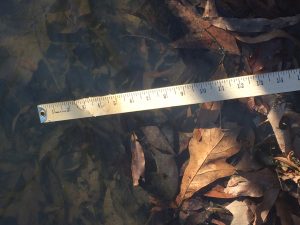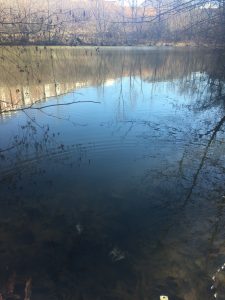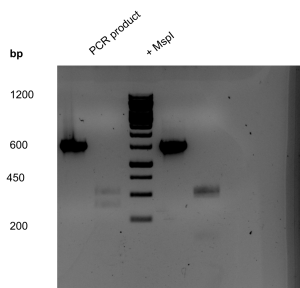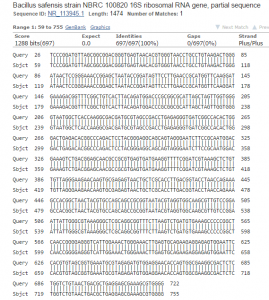Bacillus Safensis is a gram-positive, aerobic, spore-forming rod bacteria previously isolated from a spacecraft in Florida and California.
References:
1. Satomi M, La Duc M, Venkateswaran K. 2006. Bacillus Safensis sp. nov., isolated from spacecraft and assembly facility surfaces. International Journal of Systematic and Evolutionary Microbiology (56): 1735-1740 doi: 10.1099/ijs.0.64189-0
2.Boonthai T, Khaopong W, Sangsong J, Sooksawat T, Vuthiphandchai V, Nimrat S. 2016.Evaluation of the potential source of bacterial contamination during cryopreservation process of silver barb (Barbodes gonionotus) sperm. Aquaculture Research (47): 2101–2113 doi: 10.1111/are.1266
3. Kumar G, Kumar R, Sharma A. (2015). Characteristics of biosurfactants from indigenous soil bacteria recovered from oil contaminated sites. Journal of Environmental Biology (36): 1101-1104
Data collected: February 16, 2017
Methods for Isolation and Identifications:
- Twenty-five milliliters of surface water was collected in a sunny area and measured at 15.5in from the bank of the retaining pond at Lancer Park (Figure 1). Ninety microliters of the water sample were pipetted and spread across a sterile LB agar dish. The sample was incubated at 25 degrees Celsius for 18-24 hours.
- A creamy yellow colony (Figure 2) was selected for 16S rRNA gene sequencing by PCR amplification.To identify the genus and species of the bacteria the PCR product was amplified by MspI digestion and blasted using Western Blotting.
Figure 1: Site of Collection (Retaining Pond)


Figure 2: Colony selected for Identification

Results:
- MspI digestion (Figure 3)- A bp product of 1,500 was used for PCR and MspI. Out of the 3 bands, only one band appeared at 1000 bp.

Sequence analysis (Figure 4)- The PCR product sequenced 679 bases that were clear and easy to identify the genus and species. NCBI BLAST showed a 100% identity ranging from 59 to 755 of the 16s ribosomal RNA gene Bacillus Safensis.

Figure 4: NCBI BLAST colony 6-2
Contributed by: Aliyah Panizzi and Tatyana Green. BIOL 250, Spring 2017, Group 6.